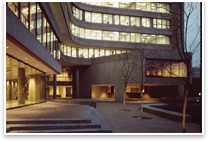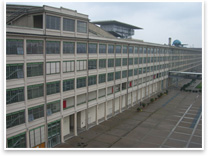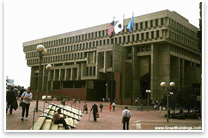 Saving
Our Future by Building on Our Past Saving
Our Future by Building on Our Past
Welcome to the “Preservation of
Modern Buildings” edition
of AIArchitect
As the 35-year-old AIA headquarters building—brilliantly designed
by The Architects Collaborative as part of a campus that embraces the
historic Octagon House—embarks on its
own journey of restoration, the
enormity has hit home for the Institute of society-wide issues that
we now see are the constant companions to restoration. This edition
reflects on many of these issues, as they in turn fittingly reflect
the three strategic initiatives of the Institute today: sustainability,
diversity, and integrated practice. 
 Preserving Modern Architecture in the Postmodern World Preserving Modern Architecture in the Postmodern World
The Modern movement in architecture produced a body of work of a
scale and impact unprecedented in the history of humankind. Modern
architecture was the physical manifestation of a broad social and
philosophical movement that forever changed the course of human
history, writes David N. Fixler, AIA, Einhorn Yaffee Prescott.
At its best, the Modern movement captured a spirit of progress,
openness, and an uplifting of the human condition, offering to
convert lofty civic ideals into physical reality. These ideas not
only reflected the sweeping social and cultural aspirations of
the day, but were also a manifestation of a response to the Enlightenment
promise of progress that continues to resonate around the world.
It is therefore imperative, Fixler says, that we continue to take
into account the context and essence of this generative philosophy
as we formulate preservation strategies, so that they may yield
interventions that both reveal and clarify the meaning of the heritage
of the Modern movement. 
 Preserving Modern Architecture: What, Why, Where, and How? Preserving Modern Architecture: What, Why, Where, and How?
Excerpted from Preservation of Modern Architecture, a new book by
Theodore H.M. Prudon, FAIA, to be released this Spring, this article
tells us that the basic process for determining what Modern buildings
to preserve is similar to the one used for more traditional buildings
(although the pertinent criteria are more complex). One fundamental
difference, however, Prudon says, is that selections for preservation
can be made ahead of time: the most important and significant properties
can be identified now. As best as possible, the Modern building
stock can then be protected, rather than waiting until time and
change diminish it so that choices about what to preserve must
be made from what remains. 
 Modern Buildings: A More Nuanced Notion of Worth Modern Buildings: A More Nuanced Notion of Worth
Today, historic preservation in the U.S. is committed to representing
the fullness of settled history and to presenting the many national
narratives that make up the greater whole of American history.
However, this has not always been the case, and the development
of this wider appreciation of the diversity of narratives within
American life has required the historic preservation movement to
alter its definition of history and the ways in which built structures
are seen to contain historical value. Ultimately, the movement
has been able to redefine the types of structures it considers
historic, growing from Mount Vernon to Modernism, writes Seth Tinkham,
who just finished his Master's thesis at the University of Heidelberg
on the preservation of Modernist, particularly Brutalist, structures.
He uses Boston City Hall as a case study, arguing that Modern architecture
is threatened with removal from the built landscape by a general
public which has conflated beautiful objects with history. 
|



